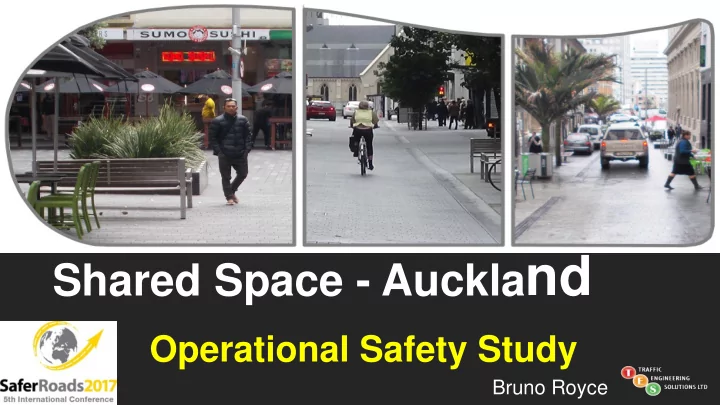

Shared Space - Auckla nd Operational Safety Study Bruno Royce
2 Conclusions: Shared Spaces more likely to be successful if their design includes: - Key Features - Desired Features.
3 Design Lower Higher Safety & Features Speeds Amenity
4 What is an Auckland Shared Space…? • A road shared by people and motorists; • Motorists give-way to people; • Traditional roadmarking, signs & kerbs replaced with a level surface; • Restricted loading & no parking.
5 Where are the Auckland Shared Spaces…? 5 Spaces currently operating in Auckland CBD were surveyed
6 What did the study involve…? • Site and video surveys all day; • International literature review.
7 Key Features Shared Space
8 Key Features
9 Key Features
10 Key Features
11 Key Features
12 Key Features
13 Auckland’s Key Features
14 Gateway – Entrance
15 Gateway – Exit
16 Level Textured Paving
17
18 Accessible / Activity Zones Fort Lane (neither) Darby St (only one side)
19 Desired Features Shared Space
Desired Features 20 1. Low Traffic Speeds 5. Active Building Frontage 2. Low Traffic Volumes 6. Circulation Zone Lateral Shift 3. Good Road Safety 7. Circulation Zone Narrow Width 4. High Pedestrian Volumes 8. Low/Moderate Loading / No Parki ng
21 Auckland’s Desired Features
22 Traffic Speeds Speeds (85 th tile) should be <= 20km/h Auckland spaces >= 20km/h 2 spaces were around 25km/h - Fort Street (east) & Federal Street
23 Traffic Volumes Volumes <= 100 vph or 1,000 vpd Most Auckland spaces satisfactory 2 spaces > 3,000vpd - Fort Street (west) & Federal St
24 Pedestrian Volumes Higher volumes = more successful space. Relatively high pedestrian volumes (>= 1,000 pph): • Elliott Street; • Jean Batten Place; • Fort St (west) Relatively low pedestrian volumes (around 200 pph): • Fort Lane
Building Frontage 25 Active building frontage = More Pedestrians Fort Ln Fort St (east) Federal Street (south section)
Circulation Zone Lateral Shift 26 Lateral shift = slower speeds (particularly on long midblock sections (>50m)). Two Shared Spaces had issues due to lack of shift: Federal St Fort St (east)
Drainage Channel Position 27 Do not align channel along circulation zone Auckland’s channels are alongside Fort St (east) Federal St
Circulation Zone ‘Side Friction’ 28 ‘Side Friction’ = Slower Speeds Greater ‘side friction’ is created with narrow circulation zone and more permanent bulk/height street furniture; Some Auckland spaces have limited ‘side friction’, particularly: Darby Street Federal Street Fort St (east)
Pedestrians On Circulation Zone 29 Pedestrians using circulation zone = more successful space Two Auckland spaces had low % : Federal St Fort St (east)
Motorists Yield To Pedestrians 30 Motorists yield to pedestrians = lower vehicle dominance Fort St (west) had particularly good result: Fort St West (high pedestrian volumes, slow speeds, and vehicle queuing)
Pedestrians Crossing 31 High volumes + Many Locations + Indirect Crossing = Lower vehicle dominance Federal – Crossing directly Darby – wandering across
Large Vehicles 32 High numbers = vehicles dominate Federal St – High Numbers of Large vehicles (7 % of traffic) & high traffic volumes
33 Legal Loading & No Parking Extensive illegal loading and parking observed in Auckland 2 Spaces in particular: Fort Street (East) Federal Street
Public Perception 34 Public survey indicated most of the public (60%) considered the spaces were working well as a Shared Space Federal Street only 48% support
35 Safer Road? Based on reported crashes, over 2- 4 years, ‘before’ and ‘after’: Fort St (west), Fort Lane and Jean Batten Pl = Safer Elliott, Darby and O’Connell Street spaces = Neutral Federal St and Fort St (east) < non-injury crashes; > crash severity (by 1 on each space).
36
37
38 Key Conclusions Auckland’s Shared Spaces were reasonably successful in terms of safety, amenity and operational performance Speeds were considered excessive at 2 spaces - Federal and Fort St (east) Volumes were considered excessive at 2 spaces - Federal and Fort St (west)
39
40 Key Recommendations To optimise success include: - All Key Features - Most Desired Features
41 In particular, keep speeds low with: - Lateral Shift of the circulation zone (if block length >50m)
42 …and: - Side Friction of the Circulation Zone
Thank you.
Recommend
More recommend